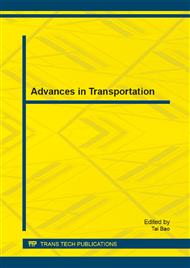p.990
p.995
p.999
p.1005
p.1014
p.1023
p.1028
p.1037
p.1041
Study on Performance Measurement of Beijing Urban Expressway Based on Microwave Data
Abstract:
The research provides an occupancy-based performance measurement for Beijing urban expressway traffic that would be beneficial for further improvement of traffic control. An analysis of the field traffic data shows that the phenomenon of speed transition happens frequently once occupancy reaches to the critical occupancy (30%). Analyzed with speed transition probability and state stability at different occupancy and speed, four traffic states could be defined as stable high-speed flow, unstable high-speed flow, unstable low-speed flow and stable low-speed flow. The performance of each traffic state is measured by transportation efficiency. The result shows that once occupancy changes from 30% to 31%, transportation efficiency drop 27.8%, representing an extra 1/4 time cost for all vehicles on road. Therefore lane occupancy should be controlled under 30% to avoid a deteriorating traffic conditions.
Info:
Periodical:
Pages:
1014-1022
Citation:
Online since:
January 2014
Authors:
Price:
Сopyright:
© 2014 Trans Tech Publications Ltd. All Rights Reserved
Share:
Citation:


